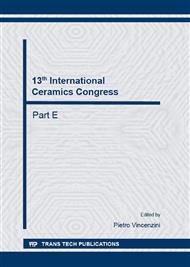[1]
Gianella, S., D. Gaia, and A. Ortona, High Temperature Applications of Si SiC Cellular Ceramics. Advanced Engineering Materials, 2012. 14(12): pp.1074-1081.
DOI: 10.1002/adem.201200012
Google Scholar
[2]
Colombo, P., Conventional and novel processing methods for cellular ceramics. The royalsociety, 2006. 364(1838): pp.109-124.
Google Scholar
[3]
Gibson, L.J. and M.F. Ashby, Cellular solids structure and properties. 2nd ed. Cambridge solid state science series1997, Cambridge: Cambridge University Press. 510 S.
Google Scholar
[4]
Deshpande, V.S., M.F. Ashby, and N.A. Fleck, Foam topology bending versus stretching dominated architectures. Acta Materialia, 2001. 49(6): pp.1035-1040.
DOI: 10.1016/s1359-6454(00)00379-7
Google Scholar
[5]
Babaee, S., et al., Mechanical properties of open-cell cellular structures with rhombic dodecahedron cells. Proceedings of the Asme International Mechanical Engineering Congress and Exposition (Imece 2010), Vol 9, 2012: pp.575-579.
DOI: 10.1115/imece2010-39924
Google Scholar
[6]
Xu, W.G., et al., The effective thermal conductivity of three-dimensional reticulated foam materials. Journal of Porous Materials, 2009. 16(1): pp.65-71.
DOI: 10.1007/s10934-007-9169-4
Google Scholar
[7]
Thiyagasundaram P., B.V.S., N.K. Arakere, Elastic Properties of Open-Cell Foams with Tetrakaidecahedral Cells Using Finite Element Analysis. AIAA Journal, 2010. 48: pp.818-828.
DOI: 10.2514/1.j050022
Google Scholar
[8]
Sullivan, R.M., L.J. Ghosn, and B.A. Lerch, A general tetrakaidecahedron model for open-celled foams. International Journal of Solids and Structures, 2008. 45(6): pp.1754-1765.
DOI: 10.1016/j.ijsolstr.2007.10.028
Google Scholar
[9]
Qu, Z.G., et al., A theoretical octet-truss lattice unit cell model for effective thermal conductivity of consolidated porous materials saturated with fluid. Heat and Mass Transfer, 2012. 48(8): pp.1385-1395.
DOI: 10.1007/s00231-012-0985-y
Google Scholar
[10]
Ali, K.S., et al., Numerical Modelling of Metal Foams with Weaire-Phelan Cell. Diffusion in Solids and Liquids Viii, 2013. 334-335: pp.122-126.
DOI: 10.4028/www.scientific.net/ddf.334-335.122
Google Scholar
[11]
Chase, M.W. and National Institute of Standards and Technology (U.S. ), NIST-JANAF thermochemical tables. 4th ed1998, Washington, DC New York: American Chemical Society ; American Institute of Physics for the National Institute of Standards and Technology.
DOI: 10.18500/1994-2540-2012-12-3-53-55
Google Scholar
[12]
Rezaei, E., et al., On the nonlinear mechanical behavior of macroporous cellular ceramics under bending. Journal of the European Ceramic Society, 2014. 34(10): pp.2133-2141.
DOI: 10.1016/j.jeurceramsoc.2014.02.034
Google Scholar
[13]
Ortona, A., S. Pusterla, and S. Valton, Reticulated SIC Foam X‐Ray CT, Meshing, and Simulation. Advances in Bioceramics and Porous Ceramics III: Ceramic Engineering and Science Proceedings, Volume 31, 2010: pp.93-104.
DOI: 10.1002/9780470944028.ch10
Google Scholar
[14]
D'Angelo, C. and A. Ortona, Cellular Ceramics Produced by Replication: A Digital Approach. Advanced Engineering Materials, 2012: p. n/a-n/a.
Google Scholar
[15]
Pusterla, S., et al., The influence of cell morphology on the effective thermal conductivity of reticulated ceramic foams. Journal of Porous Materials, 2012. 19(3): pp.307-315.
DOI: 10.1007/s10934-011-9477-6
Google Scholar
[16]
D'Angelo, C., A. Ortona, and P. Colombo, Finite element analysis of reticulated ceramics under compression. Acta Materialia, 2012. 60(19): pp.6692-6702.
DOI: 10.1016/j.actamat.2012.08.039
Google Scholar
[17]
Ortona, A., et al., Cellular ceramics produced by rapid prototyping and replication. Materials Letters, 2012. 80: pp.95-98.
DOI: 10.1016/j.matlet.2012.04.050
Google Scholar
[18]
D'Angelo, C., A. Ortona, and P. Colombo, Influence of the loading direction on the mechanical behavior of ceramic foams and lattices under compression. Acta Materialia, 2013. 61(14): pp.5525-5534.
DOI: 10.1016/j.actamat.2013.06.009
Google Scholar


